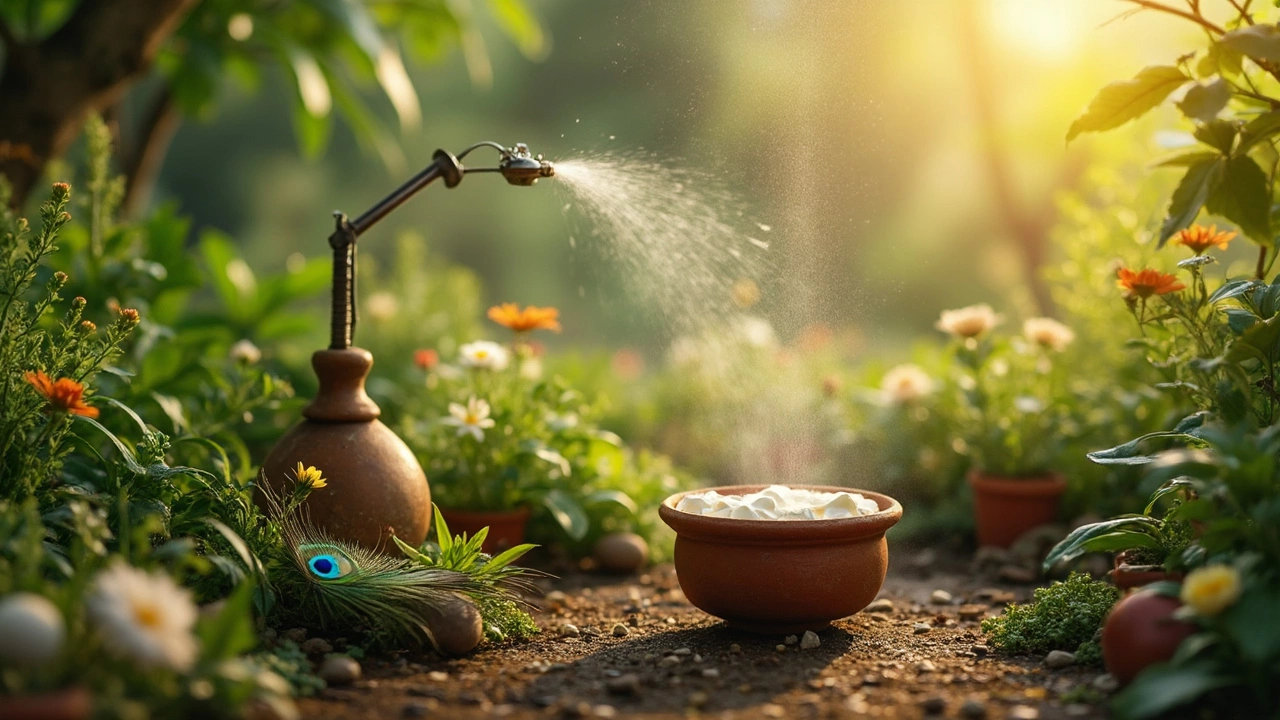Can I Drink the Whey After Making Cheese?
 Mar, 8 2025
Mar, 8 2025
So you've made your own cheese or paneer, and now you're left with this liquid gold known as whey. Before you think about pouring it down the drain, let's talk about what it is and how surprisingly useful it can be.
Whey is packed with proteins, especially if you're into fitness or just trying to eat better. It's got vitamins and minerals that make it more than just a byproduct—it's a potential health booster! Sip it, cook with it, or even use it in your garden. Seriously, there's so much you can do with whey!
But is it safe to drink right away? Absolutely. Just make sure it’s stored properly to keep its freshness. If you've got more whey than you can handle, you might want to store it correctly or find creative uses around your home.
- What Is Whey?
- Nutritional Benefits of Whey
- How to Safely Consume Whey
- Innovative Uses for Whey at Home
- Tips for Whey Storage
What Is Whey?
Whey is the liquid that gets separated from the curds during the cheese-making or homemade paneer process. If you've ever made cheese at home, you've probably noticed this slightly cloudy liquid left behind. But don't let its appearance fool you—this stuff is packed with goodies!
In simple terms, as milk coagulates into curds, whey is what's left behind. It contains a host of beneficial nutrients, making it an unexpected hero in our kitchen. Traditionally, it's been either consumed or used in cooking, but these days, some might not realize its value and just toss it.
Breaking Down the Basics
So, what exactly is in whey? This liquid isn't just water. It contains essential proteins, often considered for their high-quality and digestibility. In fact, whey protein is a popular supplement for athletes and bodybuilders. But that's just the beginning!
- Proteins: Useful in muscle building and repair.
- Lactose: Sugar that can serve as a quick energy source.
- Vitamins: Like vitamin B12 which is vital for nerve function.
- Minerals: Such as calcium and magnesium, supporting bone health.
This dairy byproduct isn't just some leftover liquid; it's a nutrient-rich component that can enhance your diet. Whether you're drinking it straight or incorporating it into recipes, understanding whey can open new culinary doors.
Varieties of Whey
Depending on the cheese or paneer you're making, the whey composition can slightly vary. For instance, sweet whey comes from rennet-based cheese making, while acid whey results from cheeses like cottage cheese or yogurt. Each type offers its own potential benefits, so don't shy away from exploring them!
Nutritional Benefits of Whey
You might not know, but whey is like a secret weapon when it comes to nutrition. That liquid left over after you make your homemade paneer is packed with goodness. Let's dig into what makes it so special.
Protein Powerhouse
First up, protein. Whey is a complete protein containing all nine essential amino acids. That makes it a go-to for gym-goers and fitness enthusiasts. It helps you build and repair muscles, which is why you often find whey in protein powders.
"Whey is not just a byproduct; it's a vital protein source that supports muscle growth and overall health," says Dr. Emily Langston, a nutritionist at the Wellness Institute.
Vitamins and Minerals
Apart from protein, whey contains vitamins like B2 (riboflavin), which boosts your energy levels. Plus, it has calcium to support bone health. If you're lactose-tolerant, the lactose content might be a concern, but whey usually contains much less than milk.
| Component | Average per 100ml |
|---|---|
| Protein | 0.85g |
| Calcium | 32mg |
| Vitamin B2 | 0.08mg |
Low in Calories
If you're keeping an eye on your calorie count, you'll be happy to know that whey is pretty low in calories. It's a good way of squeezing more nutrients into your diet without overeating.
So next time you're making cheese, don't just think of whey as waste. Consider it an opportunity to sneak in some extra nutrition. It's a simple and effective way to support your healthy lifestyle without much effort.

How to Safely Consume Whey
Before you gulp down that refreshing glass of whey, let's talk safety. Consuming whey straight from paneer making is perfectly fine—just want to make sure it’s fresh and stored adequately. Here’s how to keep it safe and tasty.
Check for Freshness
Always start with a quick sniff. If the smell is off, it's best not to consume it. Fresh whey has a mild, slightly tangy aroma—not intense or sour.
Storage Tips
- Right after you've made paneer, cool down the whey and transfer it to a clean glass jar or any airtight container.
- Keep it in the fridge where it can last about a week. But trust your nose; if it changes smell before that, it's time to say goodbye.
Drinking Whey
If you’re okay with the taste, you can drink it as is! Some people prefer mixing it with fruit juices or smoothies for added flavor.
Whey in the Kitchen
Apart from sipping it, whey can be added into your cooking! Use it in place of water for a nutrient boost in soups, breads, or even pancakes. Just substitute like you’d do with broth.
Portion Considerations
While homemade paneer whey is generally safe to drink, start with half a cup to see how your body reacts because everyone’s gut is a little different.
| Nutrient | Typical Content in Whey (per cup) |
|---|---|
| Protein | 2g |
| Calcium | 50mg |
| Vitamins | Varied B Vitamins |
If lactose is a thing for you, be cautious. Whey can contain lactose, which might not sit well with everyone.
Innovative Uses for Whey at Home
You might be surprised by how versatile whey can be after making your homemade paneer or cheese. Instead of tossing it, why not put it to good use around the house?
Cooking Magic
Whey can work wonders in the kitchen. It's an excellent liquid base for soups and stews, adding a nice tangy flavor you might enjoy. You can use it in place of water when boiling pasta, rice, or grains, infusing them with extra taste and nutrition. And if you're a bread-making enthusiast, try substituting whey for water or milk in your dough for a softer texture.
Skincare Benefits
As peculiar as it might sound, your skin can benefit from a little whey love. Rich in vitamins and proteins, whey can be a gentle face cleanser or toner. Mix it with honey or lemon juice as a natural mask to leave your skin soft and refreshed.
Green Thumb Approved
Your garden might thank you for sharing. Plants can thrive with a bit of whey added to their water, thanks to its nutrients. Just dilute it with fresh water to safeguard them from the high acidity. And if you’ve got a compost heap going, pour some whey over it to speed up the breakdown process.
Craft Beer Brewing
For the adventurous brewer, experimenting with whey might lead to some interesting flavors in your next batch of beer. It’s a unique way to add character and complexity.
Data on Whey's Nutrient Boost
| Component | Average Content |
|---|---|
| Protein | 8 g/L |
| Calcium | 60 mg/L |
| Vitamins | B2, B12 |
By giving whey a second chance, you're not only reducing waste but also reaping numerous benefits! Everything from the kitchen to personal care and gardening can find a useful place for it. It's a little secret weapon no one expects.

Tips for Whey Storage
Storing whey properly ensures that you can enjoy its benefits without worrying about it going bad. Here are some simple tips to make sure it stays fresh and ready to use.
Refrigeration is Key
Fresh whey should always be kept in the fridge. In an airtight container, it typically lasts up to a week. Make sure the lids are tightly sealed to avoid any unwanted smells or spills in your fridge.
Freezing for Long-Term Storage
If you find yourself with more whey than you can use in a week, freezing it is a great option. Pour it into ice cube trays or freezer-safe bags. This way, you can grab exactly what you need for recipes or smoothies. Frozen whey can last up to 6 months, giving you plenty of time to make the most of it.
Label Everything
It's easy to forget when you stored your whey, so slap a label on the container or bag with the date you stored it. That way, you won't have to guess if it's still good or not.
Mind the Smell and Taste
Whey should smell tangy but not off-putting. If it smells sour or the taste is off, it’s best to toss it. Always trust your senses when in doubt.
Keep Away from Direct Sunlight
Even when stored in the fridge, make sure your container is in a shady spot. Sunlight can degrade the quality of the nutritional benefits over time.
| Storage Method | Duration |
|---|---|
| Refrigeration | Up to 1 week |
| Freezing | Up to 6 months |
With these simple tips, you'll be set to integrate this nutritious byproduct into your daily life without any hassle.
